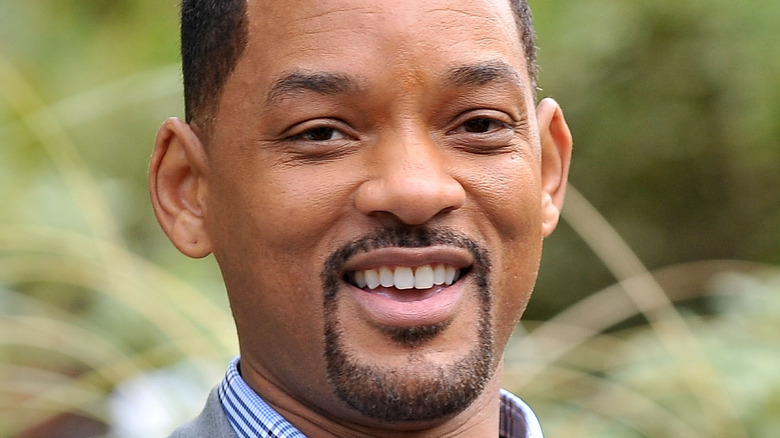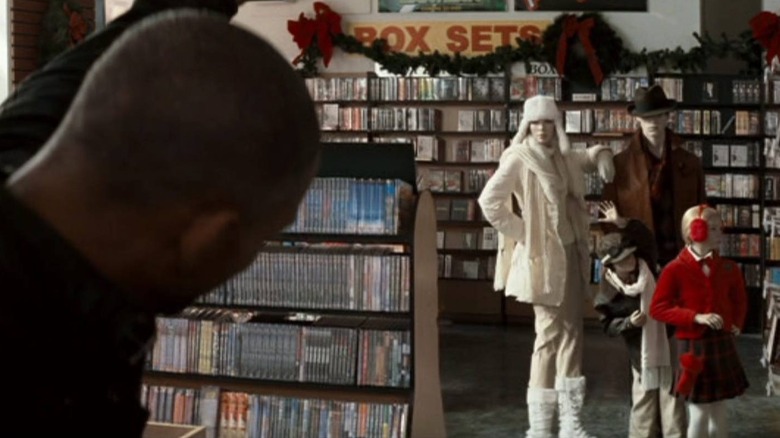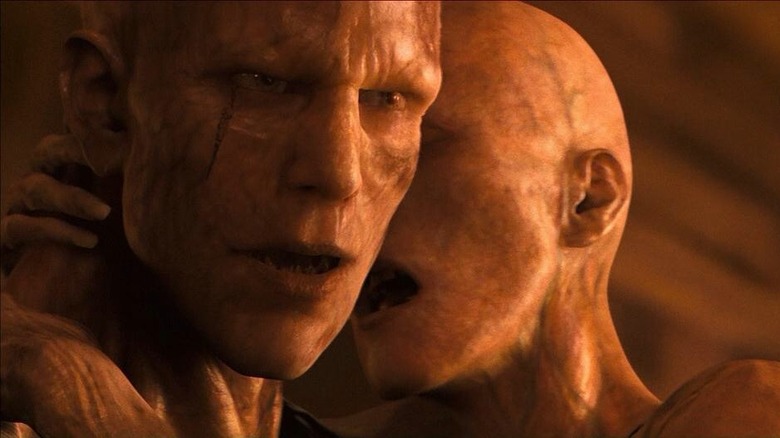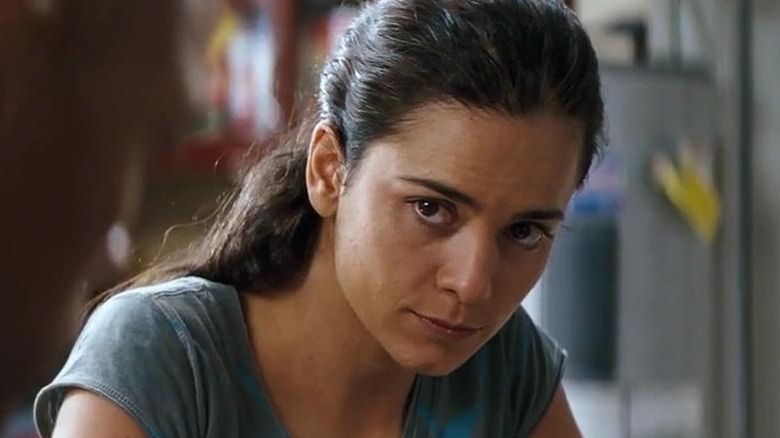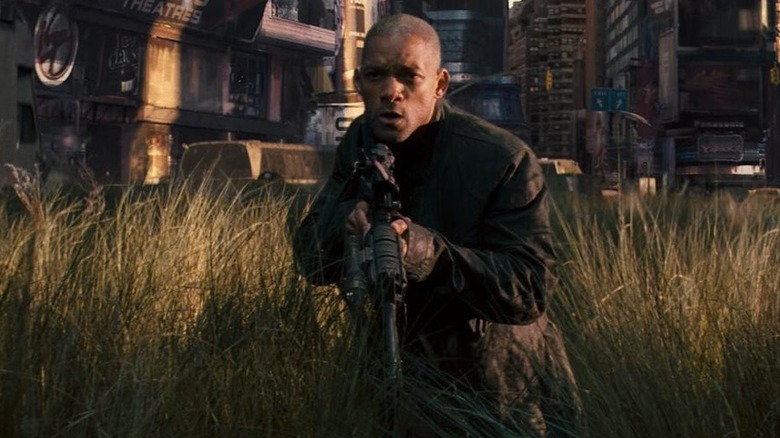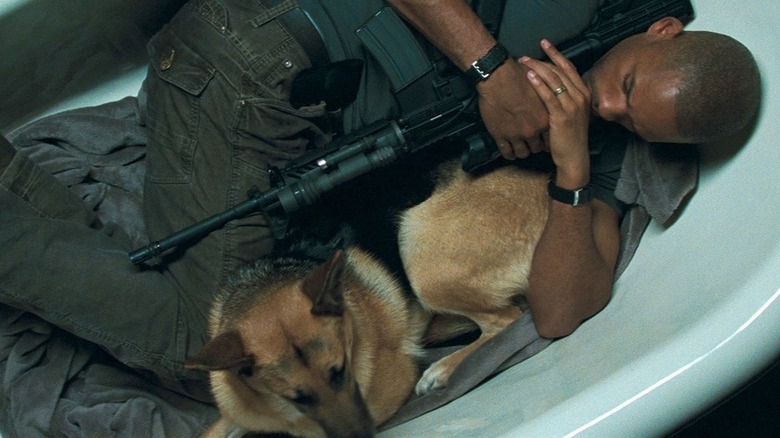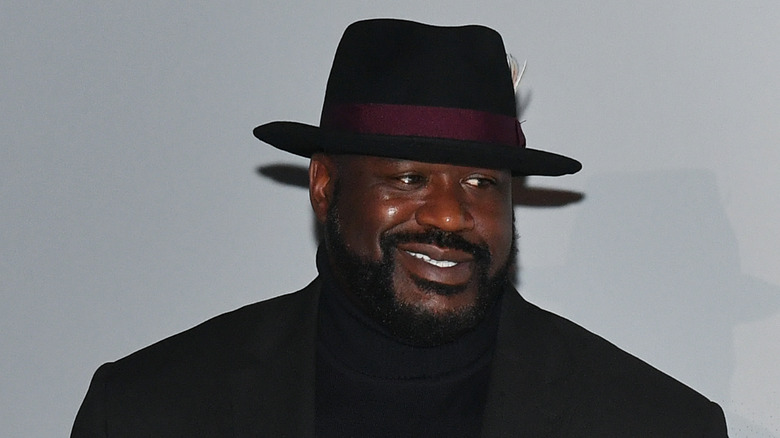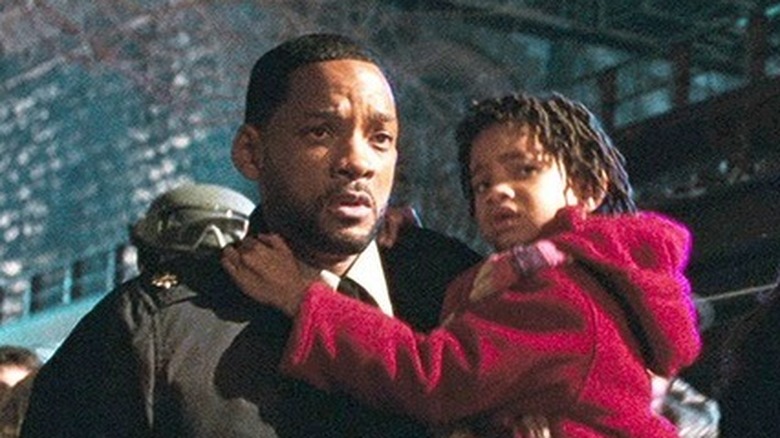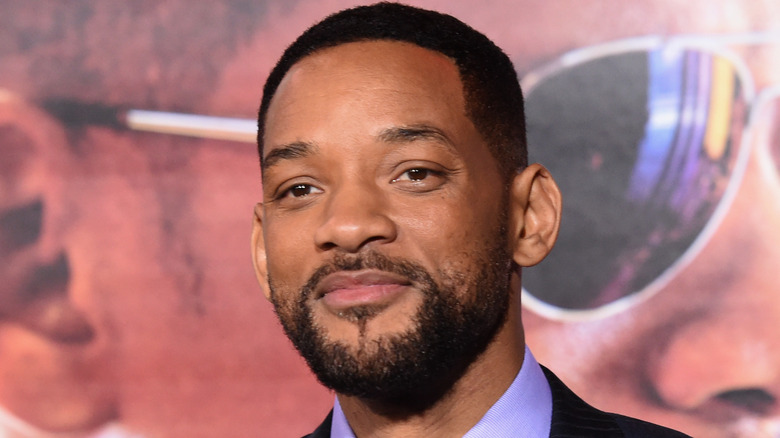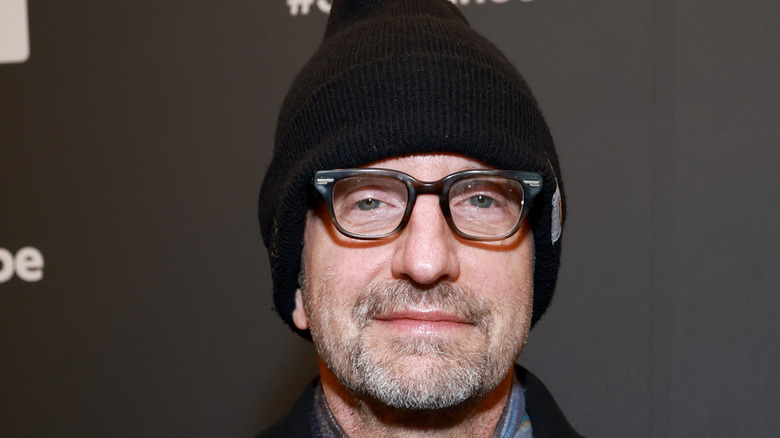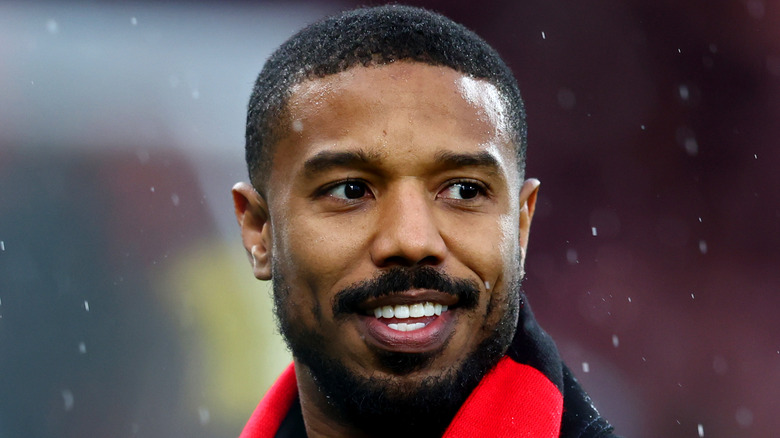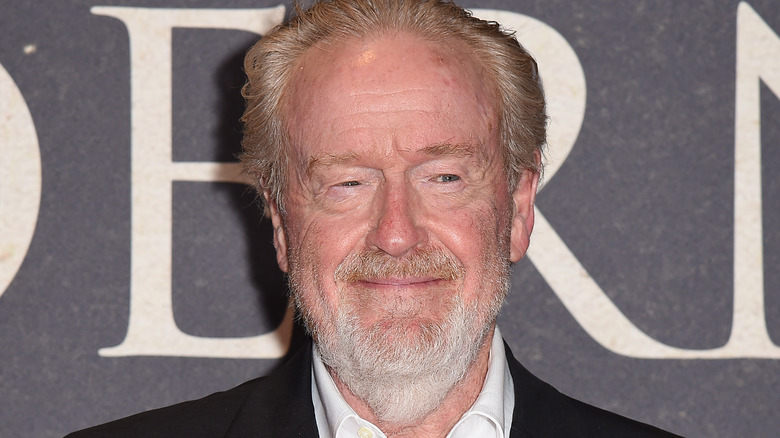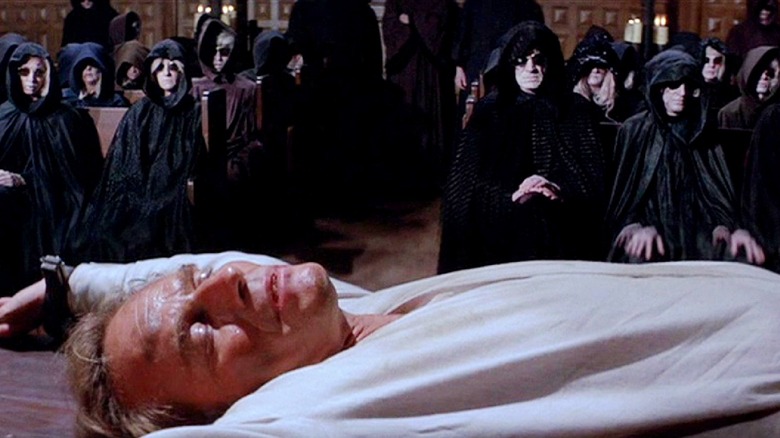Small Details You Probably Missed In I Am Legend
In the 2007 post-apocalyptic thriller "I Am Legend," Will Smith stars as Robert Neville, a former military virologist living in what remains of New York City after the catastrophic collapse of civilization resulting from a deadly virus outbreak. He is immune to the virus and is the last survivor left alive, or so he thinks at the start of the film. Safety is never a guarantee, as he has to contend with former humans who have been mutated by the virus into creatures known as Darkseekers. Though mistaken by some as zombies (as in this NPR review), they are actually closer to being vampires in origin and have also been called hemocytes.
At the time "I Am Legend" was released, Smith was hot off the success of his drama "The Pursuit of Happyness." The role had just earned him his second Oscar nomination, following 2002's "Ali." "I Am Legend" wasn't met with nearly as much acclaim, but it still enjoyed a generally warm reception from critics and audiences. Smith and the impressive post-apocalyptic world of the movie proved to be enough of a draw to make it a massive box office success despite some middling reviews. The film grossed nearly $600 million dollars worldwide and could have kickstarted a full-blown franchise. Let's dig into why that didn't materialize, along with plenty of other details and facts about "I Am Legend."
Some of the mannequins are real people
Since Robert Neville (Will Smith) considers himself to be the last human being alive in New York City and possibly the world, he feels an understandably crushing sense of loneliness. He has his dog Sam to keep him company, but that can never take the place of human-to-human interaction. One drastic method that Neville takes to combat his loneliness and isolation involves mannequins.
Neville has completely free rein in the city when not under attack by the mutated Darkseekers. This freedom has enabled him to take the mannequins from clothing stores and position them throughout the city as if they are members of the population. Neville talks to the mannequins and even flirts with one in a video store. What many viewers are unlikely to catch is that some of these mannequins are real people.
As can be seen in behind-the-scenes photos, both mannequins and actual people were used at different points throughout the film. Extras were dressed like mannequins and put in makeup to more closely resemble their inanimate counterparts. There are even moments where the mannequins can be seen moving ever so slightly. This subtle touch supports the idea that Neville's mental state is slipping in isolation, as exemplified in the scene where he screams at one of the mannequins to tell him if he's real before shooting him, which leads to his capture.
The vampires were played by real actors with CGI on top
One of the most distracting elements of "I Am Legend" was the visualization of the Darkseekers. Their function in the plot was fine, but their CGI execution left a lot to be desired. Frankly, they look terrible even by 2007's standards and are an instant immersion breaker. But the Darkseekers nearly turned out much better.
Although they look like fully CGI characters in the finished film, there were actual actors on set playing the Darkseekers. Director Francis Lawrence revealed to Den of Geek that the film started out with the intent of shooting everything with real actors wearing a combination of makeup and prosthetics. The decision to cover them up with CGI was made later, after Lawrence watched the footage and went into a panic. "It looked like a bunch of mime artists running across Washington Square Park," he recalled. "It didn't work at all."
A screen test of the original prosthetics is available online, and most would probably agree that it looks significantly better than what ended up in the movie. Part of the problem came from the Darkseekers needing to be able to move extremely quickly, which the bulkier prosthetics prevented while also making it difficult to see. When they scaled back the makeup for more maneuverability, it no longer looked convincing. Lawrence also told Den of Geek that he shares viewers' disappointment in the final CGI that ended up in the movie, saying, "It just f***ing blows it. It just kills it."
The butterfly symbolism
For the most part, "I Am Legend" is a straightforward popcorn blockbuster. It is not a film that trades heavily in subtext, but it does feature one key symbolic image: butterflies. There are actual butterflies visible in the post-apocalyptic city, illustrated butterflies on advertisements, a butterfly tattoo on Anna's (Alice Braga) neck, the glass that protects Neville from the Darkseekers cracks in the shape of a butterfly, and butterflies are explicitly mentioned in dialogue with Neville's daughter in flashbacks. The butterfly tattoo is especially important since it directly informs Neville's final decision as the Darkseekers are attacking his lab.
What do the butterflies represent? The film doesn't spell it out in detail, and some viewers have come away with different interpretations. Some consider it to be an omen that death is incoming — in a similar way to how oranges are used in "The Godfather" — while others (via GradeSaver) see it as representing a divine epiphany where memories from Neville's past give meaning to his actions in the moment and events of the future.
Historically, butterflies have been used as religious symbols (via Science Direct), but they have also been used to represent evolution. It is important to note that the butterfly in the cracked glass is positioned directly over a Darkseeker as if they are his wings. In the same way a larva evolves into a butterfly, the Darkseekers are the next evolution of humanity and aren't as monstrous as Neville perceives them to be, which makes more sense in the film's original ending.
The original ending was completely different
One of the biggest points of contention with "I Am Legend" was its ending. The ending that hit theaters was considered bad enough to ruin the entire movie for many who saw it. It also represented a major deviation away from the source material written by Richard Matheson, with David Ansen of Newsweek writing that the ending is "not likely to satisfy either the action crowd or Matheson fans."
The truth is that the ending that was released was not the original one. This original ending was eventually included on the film's DVD release and is by all metrics a considerably stronger finale than what hit theaters. This ending stuck closer to the book and delivered on the ultimate message that Neville is actually the villain of the film, as the Darkseekers he has been experimenting on have their own civilized society and view him as a monster who has been abducting and torturing them. To the Darkseekers, he is the legend that they fear, hence the title.
The ending that was released scraps this message and effectively nullifies the entire point of the story. So why was the original ending shelved? When the film was completed and had its first test screenings, the test audience hated the original ending (per Vulture) and considered it too dark. "I Am Legend" was just another in the long line of movies ruined by test audiences.
Neville's dog is actually two different dogs
Neville's only ally throughout the majority of "I Am Legend" is his trusty canine companion Sam. She just might be single-handedly (single-pawedly?) keeping him from going insane in isolation, which makes her eventual death all the more devastating. As is common practice in filmmaking (according to Insider), the single on-screen dog in the movie is actually a composite of multiple real dogs behind the scenes.
Movie dogs work closely with professional trainers off camera. Dogs often specialize in performing specific actions on command for the camera, requiring multiple specialized dogs to be able to record the full scope of actions demanded of the fictional one. In the case of Sam in "I Am Legend," two dogs were used, named Abbey and Kona. Abbey served as the primary dog, while Kona was used for specialized sequences, such as a scene where she needed to play fetch, which Abbey was not interested in doing. Eagle-eyed viewers can try to catch when the two dogs tag out, but the production went to great lengths to make that more difficult. The dogs were the same breed and looked similar to begin with, but in order to make the two fully indistinguishable on camera, they were given subtle haircuts and dog-friendly makeup.
The film predicted Shaq's retirement
One of the subtler details in "I Am Legend" is the way it plays with near-future history. Though the film was released in 2007, it suggested that the end of the world would occur in 2010. This timeline meant the production needed to predict a great number of things that might logically occur three years into the future.
After the virus has decimated the human population, the streets of New York City remain filled with advertisements that would have been timely in this imagined 2010. This includes fun predictions like a giant billboard for a "Batman vs. Superman" movie. This prediction eventually came true, with the actual "Batman v Superman: Dawn of Justice" movie coming out for real in 2016. It is impressive how similar the fake logo mocked up by the "I Am Legend" team wound up being to the actual logo released years later.
One of the smaller predictions that many viewers might have missed can briefly be spotted on a news broadcast shown within the film. On the ticker tape that scrolls across the bottom of the screen, the film predicts, among other things, that Shaquille O'Neal will retire from the NBA in 2010. The real-life Shaq ended up retiring in 2011 (via ESPN), so the prediction wasn't too far off.
Neville's daughter in flashbacks is Will Smith's actual daughter
Robert Neville's daughter Marley can briefly be seen in flashbacks in "I Am Legend." She is the one who tells him to look at the butterflies, which ties directly into the movie's key symbol. This small but important role was played by Will Smith's real-life daughter, Willow Smith. It was her first time acting, and she would play a handful of other live-action and voice-acting roles over the next couple of years before pivoting in a different showbiz direction.
These days, Willow Smith is a prominent and successful musician with multiple songs of hers landing on the Billboard Hot 100. Even die-hard fans of her music career might not have recognized her in "I Am Legend," since she was only six years old when the film was shot. Will Smith has made it a point to work alongside his family members throughout his career. On his previous film, "The Pursuit of Happyness," his real son Jaden Smith played his onscreen son. They continued acting together in other projects, such as their dual starring roles in M. Night Shyamalan's "After Earth."
Will Smith sang the same song on The Fresh Prince of Bel-Air
During a quiet, character-focused scene in "I Am Legend," Neville and Anna (Alice Braga) end up discussing his daughter Marley, who he reveals was named after musician Bob Marley. When he finds out that Anna doesn't know who that is, he sings "I shot the sheriff, but I did not shoot the deputy," before putting on a Bob Marley CD and comparing Marley's fight against racism with music to his fight as a virologist trying to cure the plague that wiped out humanity.
On its own, the scene is memorable enough. What makes it more notable is the fact that Will Smith sung those exact same lyrics 16 years earlier during the first season of his breakout sitcom, "The Fresh Prince of Bel-Air." In Season 1, Episode 20, Smith enters the kitchen while wearing a Bob Marley costume and singing "I Shot the Sheriff." He even uses the same falsetto impression and cuts the song off at the exact same point.
A prequel film was scrapped
With the major financial success of "I Am Legend," it's a bit of a surprise that the property never expanded into a full-fledged franchise. It didn't happen, but it wasn't for lack of trying. In the immediate aftermath of the film's success, both a sequel and a prequel came close to entering production.
According to MovieWeb, one of the main reasons why the prequel was scrapped was the release of Steven Soderbergh's movie "Contagion." That 2011 release featured a plot that was considered too similar to the ideas that would have been explored in the "I Am Legend" prequel, which would have been set before the Darkseekers became the dominant species left on Earth. A script for the potential prequel was never finalized and the project never moved beyond the development phase. A sequel obviously didn't follow hot on the heels of the original, but that doesn't mean it was scrapped altogether.
The long-delayed sequel is still in the works
Plans for a potential "I Am Legend" prequel and sequel began shortly after the release of the original. The prequel never came to be and, for a while, that seemed to be the case for the sequel as well. But despite being massively delayed, the sequel was apparently still in the works as of March 2022, according to Deadline. After progress was stalled for many years, the project finally picked up momentum, with Will Smith and Michael B. Jordan set to star and serve as producers. Akiva Goldsman had also been confirmed to pen the script after getting a co-writing credit on "I Am Legend" with Mark Protosevich.
Then Will Smith slapped Chris Rock at the Oscars, creating worldwide shockwaves and putting his future film plans temporarily on hold. Little has been heard about "I Am Legend 2" since then, although the original's director, Francis Lawrence, told Comicbook.com in November 2022 that he had spoken with Goldsman about it and was interested in getting involved, adding, "I think that is still a ways away."
On its face, the idea of Smith returning sounds confusing since his character died at the end of the film. How that would be resolved has yet to be confirmed, but one way might be to make the original cut's ending — which had Neville surviving — the official canon moving forward. That, however, would likely puzzle the many viewers who only saw the theatrical ending.
Ridley Scott almost made his own version of the film
Before "I Am Legend" took the shape we know today, it nearly existed in a drastically different form. A full decade earlier, Ridley Scott planned to make his own version of the film (via Den of Geek). It was in 1997 that his take on the material would have come to fruition, the same year he ultimately released "G.I. Jane" and shortly before he earned his second Oscar nomination for "Gladiator."
Scott's version was initially based on a screenplay written by Mark Protosevich, who remains credited on 2007's "I Am Legend." However, according to Den of Geek, Scott was unsatisfied with Protosevich's script and sought a new version penned by John Logan, who would end up writing "Gladiator" for Scott and earning his first of three Oscar nominations. Scott's iteration of "I Am Legend" would have been set in Los Angeles instead of New York, it would have been nearly silent for the entire first act, and it would have featured Arnold Schwarzenegger in the lead role.
The project was eventually canned but not before a considerable amount of work was done in pre-production. Special effects and makeup tests made for the film can even be found online to give you a glimpse of what could have been.
I Am Legend is the third version of the novel
"I Am Legend" is the third adaptation of Richard Matheson's novel of the same name, but oddly enough, it was the only one to keep the title of the book. The first adaptation was made all the way back in 1964 and was titled "The Last Man on Earth." This version starred horror icon Vincent Price in the Robert Neville role, though he is actually called Robert Morgan in that version. Matheson co-wrote the screenplay, but wasn't happy with the results and wound up being credited under the pseudonym Logan Swanson. Matheson told Cemetery Dance magazine (via Den of Geek) that he was disappointed by the film, felt that Price was miscast, and considered the direction to be lackluster. While it deviates from the book, this version stays truer to the source material in many key areas, including the themes and ending.
Seven years later, the next adaptation hit theaters. The title was changed again, this time to "The Omega Man," with Charlton Heston playing the lead character, whose name was changed back to Neville. This version is the most action-centric, with Heston aiming for "badass hero" instead of "lonely and depressed doctor." The vampiric mutants faced by Neville are much smarter and more organized than in any other telling of the story, which supports the idea of them being the next evolution of humanity and Neville being the real villain to them.
